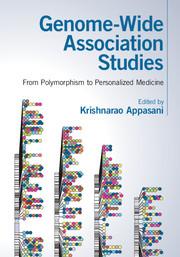Book contents
- Frontmatter
- Dedication
- Contents
- List of contributors
- Forewords
- Preface
- List of abbreviations
- Part I Genome-wide association studies
- Part II Genome-wide studies in disease biology
- Part III Single nucleotide polymorphisms, copy number variants, haplotypes and eQTLs
- Part IV Next-generation sequencing technology and pharmaco-genomics
- 15 Next-generation sequencing for rare diseases
- 16 Next-generation sequencing for complex disorders
- 17 Chromosomal breakpoints in breast cancer co-localize with differentially methylated regions
- 18 Signaling network analysis of genomic alterations predicts breast cancer drug targets
- 19 Pharmacogenetic studies in pediatric acute myeloid leukemia
- 20 Pharmaco-genomics of antiretroviral drugs
- Part V Population genetics and personalized medicine
- Index
- Plate section
- References
18 - Signaling network analysis of genomic alterations predicts breast cancer drug targets
from Part IV - Next-generation sequencing technology and pharmaco-genomics
Published online by Cambridge University Press: 18 December 2015
- Frontmatter
- Dedication
- Contents
- List of contributors
- Forewords
- Preface
- List of abbreviations
- Part I Genome-wide association studies
- Part II Genome-wide studies in disease biology
- Part III Single nucleotide polymorphisms, copy number variants, haplotypes and eQTLs
- Part IV Next-generation sequencing technology and pharmaco-genomics
- 15 Next-generation sequencing for rare diseases
- 16 Next-generation sequencing for complex disorders
- 17 Chromosomal breakpoints in breast cancer co-localize with differentially methylated regions
- 18 Signaling network analysis of genomic alterations predicts breast cancer drug targets
- 19 Pharmacogenetic studies in pediatric acute myeloid leukemia
- 20 Pharmaco-genomics of antiretroviral drugs
- Part V Population genetics and personalized medicine
- Index
- Plate section
- References
Summary
Introduction
Thousands upon thousands of tumors have been sequenced so far, representing over 20 different cancer types. These efforts allowed scientists to take a closer look at the genomic alterations (i.e., mutations and copy number variations) within a tumor's genome, in order to be able to potentially explain the underlying mechanism that drives cancer cell survival and proliferation (Banerji et al., 2012; Cancer Genome Atlas Network, 2012; Stephens et al., 2012). However, extracting useful information from a vast source of various data types to establish a link between genomic alterations and the driving force behind cancer cells remains a challenge (Chin et al., 2011).
Over the past decades of cancer research, scientists have learned that during the evolution of normal cells to cancer cells, different genomic alterations are compiled. These alterations can impact gene expression and protein function to modulate certain fundamental characteristics (i.e., cancer hallmarks) of a cancer cell. Cell survival, proliferation, and apoptosis are among the most primitive cancer hallmarks (Hanahan and Weinberg, 2011). The accumulation of genomic alterations allows cancer cells to reach a neoplastic state that enables them to proliferate indefinitely and become nearly immortal. However, these changes appear to be random, with no patterns that can be used for classifications of patients or identifying drug targets for treatment.
Recent studies (Schlabach et al., 2008; Silva et al., 2008) have gone on to identify genes that are required for cancer cell survival and proliferation (i.e., essential genes). They accomplished this by performing a genome-wide RNAi knockdown screening for different cancer cell lines from three different cancer types, whereupon a gene was considered to be an essential gene if the knockdown of that gene reduced the cell's survival and proliferation based on p-values. A key observation to note in these RNAi knockdown studies is that different cancer cell lines had different sets of essential genes, implying that the cancer hallmark traits, such as survival and proliferation, can be affected by different sets of genes. This was true for cell lines that belong to the same cancer type. Therefore, no two lung cancer cell lines, for example, had identical sets of essential genes, although there was some overlap. In addition, there was no one gene that appeared to be essential across all the different lung cancer cell lines.
- Type
- Chapter
- Information
- Genome-Wide Association StudiesFrom Polymorphism to Personalized Medicine, pp. 269 - 280Publisher: Cambridge University PressPrint publication year: 2016

